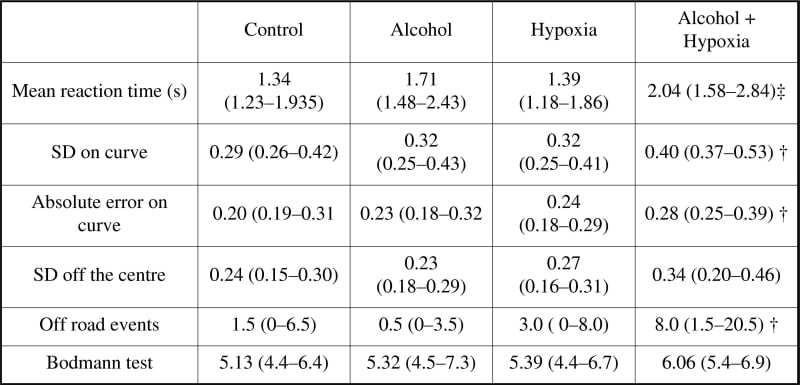Alcohol and hypoxia are known to affect performance, but their combined effects are poorly understood. We have studied the effects of (1) control (air + no alcohol), (2) blood alcohol concentration (BAC) – 0.8mg/ml, (3) hypoxia (80-85% O2 saturation) and (4) alcohol and hypoxia combined using a divided attention driving simulator (DADS, Stowood Scientific, Oxford) and the Bodmann visual acuity test [1]. Following a practice session using the DADS system, 10 normal subjects (4 male; median age 21 years, range 20-22 years) completed 4 study sessions, each at the same time of day in the afternoon, in a randomized order. At each session, subjects consumed a 570ml drink of 50:50 cranberry juice:grapefruit juice and waited 30 min before starting the DADS test, which lasted for 20 min. This was followed immediately by the Bodmann test. BAC was calculated for each subject using Forrest’s algorithm of the Widmark equation [2], rearranged to obtain the volume of 100% ethanol required to achieve a BAC of 0.8mg/ml. Data from the DADS was analysed for reaction times, off road events, the ability to follow the centre of the road and the ability to turn the wheel in relation to the curve of the road. The Bodmann test was analysed for the time to complete the test. Data were analysed using Friedman’s ANOVA with Dunn’s multiple comparison test and are given as median (interquartile range). Hypoxia was maintained at levels between 80-85% saturation throughout each study. There were significant differences between (alcohol + hypoxia) and control for off-road events, absolute error and standard deviation of the curve and reaction time (Table 1). There were no significant differences between sessions for the Bodmann test or the standard deviation off the centre. In normal young subjects the combined effects of alcohol at a BAC of 0.8 mg/ml and hypoxia at 80-85% O2 saturation appear to impair the ability of subjects to undertake tasks requiring fine motor co-ordination and quick reactions, whereas hypoxia or alcohol alone at the levels studied do not.
University of Bristol (2005) J Physiol 567P, C139
Oral Communications: Effects of alcohol and hypoxia on driving simulator performance and visual acuity in normal, young subjects
Colombo, John; Morton, Jessa; Taylor, Sarah; Kendrick, Adrian H;
1. Physiology Department, University of Bristol, Bristol, United Kingdom. 2. Department of Respiratory Medicine, Bristol Royal Infirmary, Bristol, United Kingdom.
View other abstracts by:
Table 1. Summary of significant results.Mean reaction time measure of complex reaction time; SD on curve standard deviation of difference between steering angle and road angle; Absolute error total difference between steering angle and road angle; SD off the centre standard deviation of the centre of the car from the centre of the road; Off road events number of times the car left the road. †p < 0.05 vs control; ‡p < 0.01 vs control.
Where applicable, experiments conform with Society ethical requirements.

